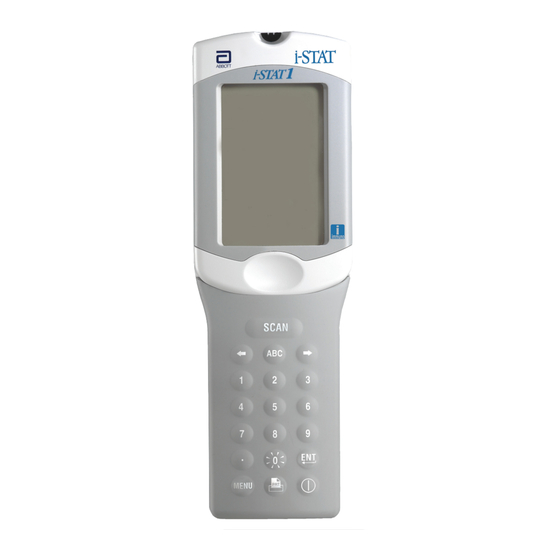Abbott i-STAT 1 Manual del usuario - Página 4
Navegue en línea o descargue pdf Manual del usuario para Instrumentos de medida Abbott i-STAT 1. Abbott i-STAT 1 9 páginas. For use with a clia certificate of waiver
También para Abbott i-STAT 1: Manual de consulta rápida (7 páginas)

n
CHEM8+ Cartridges
a.
CHEM 8+ cartridges require the use of whole blood collected in non-
heparinized evacuated tubes or syringes, as long as sample is tested
immediately upon draw, or;
b.
Heparinized whole blood collected in balanced heparin syringes or capillary
tubes, or;
c.
Heparinized whole blood collected in evacuated tubes containing lithium
heparin, as long as the tubes are filled to capacity.
n
Troponin I/cTnI, ß-hCG and CK-MB Tests
a.
cTnI and CKMB cartridges require the use of heparinized whole blood or
plasma samples collected in syringes or evacuated tubes containing lithium
or sodium heparin and filled to capacity, or;
b.
Non-heparinized whole blood or plasma samples tested within one minute
of drawing from a patient into a plastic syringe or plastic evacuated tube
containing no additives.
•
The use of whole blood or plasma samples containing other anticoagulants such as
EDTA, oxalate, and citrate will cause deactivation of the alkaline phosphatase,
resulting in decreased cTnI, ß-hCG or CK-MB readings.
•
Capillary tubes and direct skin punctures (e.g., fingersticks) should not be used
with the cTnI, ß-hCG or CK-MB cartridge.
n
BNP Tests
•
BNP catridges require the use of EDTA whole blood or plasma samples collected
in plastic syringes or evacuated tubes containing EDTA and filled to capacity.
•
The use of whole blood or plasma samples containing other anticoagulants such
as oxalate and citrate is not recommended.
•
Capillary tubes and direct skin punctures (e.g., fingersticks) should not be used
with the BNP cartridge.
Limitations
Interfering substances in the patient's sample may cause an increase or decrease in a
result. Refer to the Cartridge and Test Information Sheets and Technical Bulletins for
substances and/or conditions that may interfere with cartridge tests.
4
Charging Rechargeable Battery in External Recharge Compartment
Placing a rechargeable battery into the recharging compartment will automatically initiate
trickle recharging. The indicator light near the recharging compartment will be green when a
rechargeable battery is placed in the compartment.
STEP / ACTION
1
The battery pack has two labels: one for orientation in the handheld and one for
orientation in the Downloader/Recharger. With the label with the Downloader facing
up and the electrical contact end of the pack facing the contacts in the battery
compartment, insert the pack into the compartment as shown on the label.
2
To remove the battery after it is charged, back the pack out of the compartment.
Full recharge from a discharged state takes approximately 40 hours.
Caution
If you are using rechargeable batteries, use only rechargeable batteries and recharging
equipment supplied by your i-STAT distributor. Other batteries and rechargers may affect test
results and pose other hazards to operators and patients.
Cleaning the Handheld and Downloader
Please see Section 17 of the i-STAT 1 System Manual (Routine Care of the Analyzer &
Downloader) for instructions on cleaning and decontaminating the handheld and
downloader.
Replacing Paper in the Martel Printer
1.
Squeeze the front and back of the paper cup to open.
2.
Remove remaining paper by pressing the Paper feed button. Do not pull paper
through printer mechanism.
3.
Reel off a few centimeters of paper from the new paper roll and check that the
end has a clean straight edge.
4.
Slide the leading edge of the paper through the paper entry slot until you feel
resistance. Paper feeds from underneath the roll.
5.
Press the Paper Feed button and feed the paper through the printer mechanism.
6.
Keep the Paper Feed button depressed until the paper passes through the
paper exit slot.
7.
Sit the new paper roll in the paper cup and close the lid.
13
